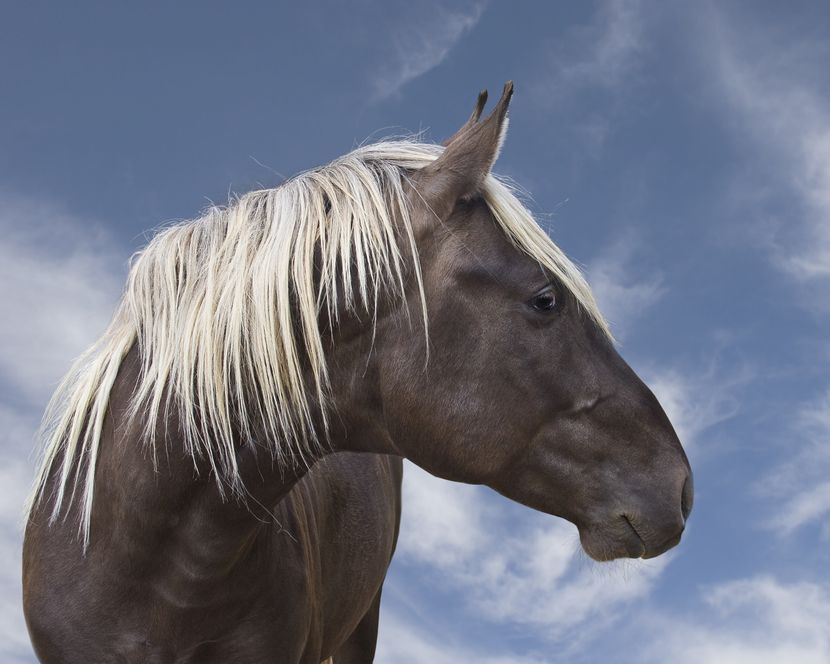
A mutation of the PMEL17 gene in brown and black horses gives them the appearance of gods, but takes its toll in the form of serious problems with one of the most important senses
A "silver" horse doesn't have the look and color of its "metallic" namesake, although that would be awesome: instead, the silver in the horse's name refers to a genetic trait that gives dark-bodied horses light-colored manes and tails. This contrast gives them a stunning look that catches the eye, wherever they appear.
The mane and tail of a "silver" horse can vary in color: the most common shades are flaxen and silver gray, and some horses' mane and tail darken with age, writes Pethelpful.
Not all light manes indicate a silver color. Some gray horses have light or white manes and tails, and unlike true "silver" dark-bodied horses, a gray horse's coat often lightens progressively until it becomes completely white, by the age of six or eight. Gray horses and other white-coated horses - such as tobiano, frame and overo horses - do not have the same color genetics as silver horses.
Silver gel PMEL17
The mutation of the PMEL17 gene causes the appearance of light hair in "silver" horses, because it dilutes the dark pigment, more precisely, it lightens the black and brown pigment. However, the effect is not limited to the horse's mane and tail: a completely black horse known as "black silver" will have a chocolate-colored body and light tail and mane.
Black horses with the mutation can also have a light gray coat ("silver spots"). There are horses with a flaxen colored mane and tail with a small amount of black pigment on the legs that are nicknamed "Gulf Silver" or "Red Silver".
How "silver" DNA is inherited
Dilution of "silver," as the condition is sometimes called, is inherited as a dominant trait. This means that the foal will be "silver" if only one parent carries the silver gene. Although this genetic structure is seemingly easy to inherit, silver is still considered one of the few colors in the general horse population. Horses with two copies of the silver gene (Z/Z) are most likely to pass silver to all their offspring, regardless of whether they are mated to "silver" or "non-silver" horses. Colts with one copy of the silver gene (Z/N) have a 50 percent chance of producing a "silver" foal, even when bred to a horse that does not carry the silver gene.
What breeds give silver throats
Many horse and pony breeds are known to carry the silver mutation: Morgan, Icelandic horse, Shetland pony, Gipsy Cob, Welsh pony, Colored horse, Australian cattle horse, Quarter (and related breeds), Rocky Mountain horses (and related breeds), French draft horse.
The first silver horse
It is difficult to find the origin of the gene for silver, therefore it is also difficult to explain why some breeds are more "silver" than others. It could be assumed that each of the affected races had a fertile ancestor who had this mutation. One such recorded example involves the Morgan horse: it is believed that all silver lines in Morgans can be traced back to a horse named Dan. He was a registered chestnut stallion from 1916. Dunn is believed to have produced the first silver foal when he was mated to the dark wild mare Nellie Skinner. However, there is a chance that Nellie was the original source of the silver gene, not Dan.
Good looks, bad eyes
A mutated PMEL17 gene could give silver horses a beauty edge, but that often comes at a price. The silver mutation is linked to an inherited eye disease called Multiple Congenital Ocular Abnormalities Syndrome (MCOA). MCOA results in several damages to the eye, mostly near the front or back of the visual organ. The severity of the condition depends on how many copies of the gene the horse has inherited: horses with one copy have less severe symptoms and may only develop eye cysts, but horses with two copies often have a deformed iris or retina (or both) and may suffer from corneal enlargement.
To avoid eye damage in future generations, breeders should test all offspring of silver horses for this disease.


